Two Lakelanders continue the Florida legacy of forging and appreciating knives
Photography by Penny & Finn
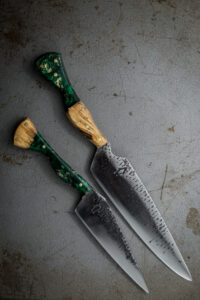 Knives have always been part of Florida’s culture. The first native people who settled in Florida nearly 12,000 years ago used knife-like tools. The storied Florida Crackers were fond of Bowie knives, and those blade designs are still widely used today. Today, two Lakeland men continue that tradition.
Knives have always been part of Florida’s culture. The first native people who settled in Florida nearly 12,000 years ago used knife-like tools. The storied Florida Crackers were fond of Bowie knives, and those blade designs are still widely used today. Today, two Lakeland men continue that tradition.
One of those men, Patrick Gaskins, runs The Knife Place, a small knife shop on the outskirts of town. Gaskins grew up in Georgia, where using knives was as common as getting dressed. “I grew up in a small town, and we always used knives,” he says. “It was just one of those things where, as a man in a small town, you always carried a pocket knife. We hunted a lot; we fished a lot; so you always had one. Otherwise you weren’t prepared for the day.”
Gaskins collected knives as a child and was first acquainted with The Knife Place when he traveled to Lakeland from his hometown in Nashville, Georgia, with his parents. It wasn’t until he began working in the produce industry in Plant City that he revisited the knife shop he had frequented when he was young. Gaskins said that once he rediscovered The Knife Place, he would go there and spend his paychecks on knives to add to his collection. He never suspected that he’d buy the store itself. The shop’s original owner, Dick Plank, opened the store in 1989 and ran it for 20 years. Gaskins bought the shop five years ago, even though he’d only intended to buy a knife. “I kept aggravating Dick about a certain
knife,” Gaskins says. “I kept asking, ‘Dick, when are you gonna sell it to me? When are you gonna sell it to me?’ And one day I came in and asked, ‘Dick, when are you gonna sell me that knife?’ And he said, ‘If you’ll just hold up a minute, I’ll sell you the whole darn place.”
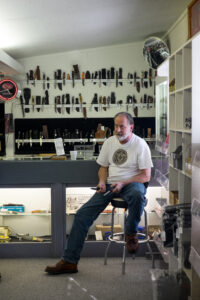 Since then, Gaskins has stocked The Knife Place with every kind of knife imaginable. Throwing knives and tactical knives sit next to cases full of bone-handled blades. In pride of
Since then, Gaskins has stocked The Knife Place with every kind of knife imaginable. Throwing knives and tactical knives sit next to cases full of bone-handled blades. In pride of
place, a display of locally made custom knives is full of unique, handmade pieces. Axes in tooled leather sheaths and magnetic strips stacked with more pieces line the walls. Despite the variety in the shop, Gaskins has a preferred style. “You’ve got people who carry modern pocket knives,” he says, “but I’m more of a traditionalist.”
The Knife Place’s regulars undoubtedly share his traditionalist mindset. One group of men gathers at the shop nearly every day to swap stories with strangers and friends alike. Gaskins notes, “They want to hear everybody’s stories, what’s going on. You’ve got several older custom makers that come in regularly on Wednesday mornings. They just want to
talk to everybody.”
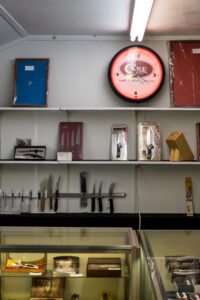 The regulars are full of stories and knowledge about knife-making. Several of them are older custom makers, and they’re willing to share their insight: “They never meet a stranger,”
The regulars are full of stories and knowledge about knife-making. Several of them are older custom makers, and they’re willing to share their insight: “They never meet a stranger,”
Gaskins says. “Lots of times, [someone new] will come in and want to know about a custom knife, and I’ll just direct them to those guys. They’ve been doing it for 40 years.”
Despite the wealth of knowledge and knife-making history in his shop, Gaskins is uncertain about the future of knife collecting. The Knife Place stays busy, but he says that many young people today have less disposable income. Student loans, rising housing costs, and other expenses leave little room for younger people to build valuable knife collections. “It’ll be interesting to see what happens with it,” he says. Regardless, Gaskins will continue offering knives, new and old, curating his own collection, and sharing stories at his shop.
Knife-making may be an ancient art, but Jonathan Porter is keenly aware of the science that goes into each knife. Every stroke of the hammer has an effect on the finished product.
On the other side of town, another man connects with knives’ history in a different, more physically demanding, way. Like the old-timers at The Knife Place, Jonathan Porter of DogHouse Forge forges his own custom knives. Porter, an American Farrier’s Association certified farrier, shoes horses when he’s not working in his forge. His profession was his gateway into forging knives; his blacksmithing know-how and familiarity with the required tools made the transition relatively easy. “I started forging knives at horse shows,” he says. “I just got bored and decided to do it.” His hobby grew, and he eventually opened DogHouse Forge. Each of Porter’s knives is hand-forged from assorted pieces of high-quality carbon steel, from vintage sawblades to railroad spikes. His steel often comes in the form of farrier rasps, the tools of yet another historic trade. Farrier rasps are long, coarse, steel tools used to even a horse’s hoof before fitting it with a shoe. Porter says the rasps can be used for only a few jobs before they’re discarded. They’re readily available; between his own farrier work and his network of colleagues, used rasps are abundant. “I have friends with whole trash cans full of them,” he says.
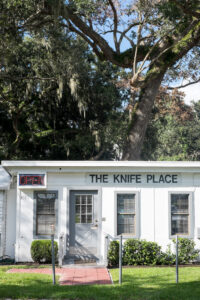 Porter spends days transforming a single rasp into a knife. They’re heated, hammered out, shaped, ground down, and hardened. It’s a very physical process, requiring extreme temperatures, heavy mallets, and all manner of hammers and hand-tools. Watching Porter swing a piece of red-hot metal from forge to anvil recalls the centuries-old old vocation of blacksmithing, though he is sometimes aided by more contemporary tools like an air hammer and mechanical grinder. Finished blades are outfitted with a unique handle made from a variety of woods from all over the globe. The process takes about three days from start to finish. Knife-making may be an ancient art, but Porter is keenly aware of the science that goes into each knife. Every stroke of the hammer has an effect on the finished product. Every beat of the hammer on one side of the knife is repeated on the other side — otherwise, Porter says, the finished knife will be unbalanced. “In order to recycle a rasp or file into a knife, you need to completely break down its structure so that you can move it around into the shape you’re after,” he explains. “By breaking that structure apart, you disrupt the uniformity of the atoms and, in turn, the molecular alignment in the steel. The goal in forging and rehardening a blade is to get this uniformity and density as evenly spaced as possible in order to guarantee the blade’s strength is equal throughout.”
Porter spends days transforming a single rasp into a knife. They’re heated, hammered out, shaped, ground down, and hardened. It’s a very physical process, requiring extreme temperatures, heavy mallets, and all manner of hammers and hand-tools. Watching Porter swing a piece of red-hot metal from forge to anvil recalls the centuries-old old vocation of blacksmithing, though he is sometimes aided by more contemporary tools like an air hammer and mechanical grinder. Finished blades are outfitted with a unique handle made from a variety of woods from all over the globe. The process takes about three days from start to finish. Knife-making may be an ancient art, but Porter is keenly aware of the science that goes into each knife. Every stroke of the hammer has an effect on the finished product. Every beat of the hammer on one side of the knife is repeated on the other side — otherwise, Porter says, the finished knife will be unbalanced. “In order to recycle a rasp or file into a knife, you need to completely break down its structure so that you can move it around into the shape you’re after,” he explains. “By breaking that structure apart, you disrupt the uniformity of the atoms and, in turn, the molecular alignment in the steel. The goal in forging and rehardening a blade is to get this uniformity and density as evenly spaced as possible in order to guarantee the blade’s strength is equal throughout.”
 The knives made at DogHouse Forge are attracting interest around the country. As Porter gains more customers, his work gets more attention. He’s gained a substantial following
The knives made at DogHouse Forge are attracting interest around the country. As Porter gains more customers, his work gets more attention. He’s gained a substantial following
on Instagram and Etsy, among others. His clients — from professional chefs to home cooks — all recognize the quality and workmanship of his knives. The knives are a perpetual
work of art; the steel changes ever so slightly after each use. Porter says, “A very special thing for me about a forged knife is the patina it develops during its lifetime of use. Each food has its own enzymes and acids that react with the steel to give its patina life. This becomes your knife’s story or its fingerprint. Every time you use it, the meal you’ve prepared is added to the log book.” Porter’s beautifully forged knives continue to improve and change as they are used — a creative process that is never truly finished.
Perhaps Porter’s knives will one day sit in The Knife Place’s case of locally made knives. He and Gaskin both share a similar appreciation for the storied skill of forging steel, although they pursue their interests differently. In Gaskins’ shop, the rows of knives gleaming quietly in glass cases are the result of a childhood appreciation for well-crafted blades that inspired a career. In Porter’s shop, the same appreciation for a well-made knife is expressed in hot steel and flying slag.
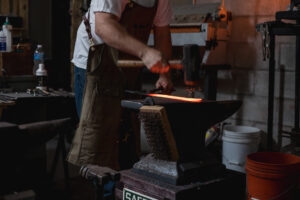 Knife-collecting and blacksmithing are no longer common hobbies or vocations, but Gaskins and Porter both have advice for those interested in exploring those topics. Gaskins’ advice to fledgling knife collectors is to start small. “They just need to figure out what direction they want to go in,” he says. “If they’re going into the older-style knives, I would tell them to pick a style and a brand that they like. Otherwise it’s too broad, and you can invest way too much money really quick.” He also suggests collecting knives by year and recommends that fans of contemporary, tactical-style knives focus on collecting a particular brand.
Knife-collecting and blacksmithing are no longer common hobbies or vocations, but Gaskins and Porter both have advice for those interested in exploring those topics. Gaskins’ advice to fledgling knife collectors is to start small. “They just need to figure out what direction they want to go in,” he says. “If they’re going into the older-style knives, I would tell them to pick a style and a brand that they like. Otherwise it’s too broad, and you can invest way too much money really quick.” He also suggests collecting knives by year and recommends that fans of contemporary, tactical-style knives focus on collecting a particular brand.
Learning the art of hand-forging knives is not as simple. Porter cautions, “It’s not a process you can just jump into, and start-up is expensive. Forges, anvils, grinders, belts, hand tools, and a heat-treatment oven are not cheap or ligh-hearted investments. People should be prepared to ruin lots of attempts and for the process to be much more laborious than they probably imagine.” His advice is to explore the hobby before committing to getting started, ideally by watching other artisans work in their own forges. Porter warns,
For those that get bit by the forging bug, I will warn you, it’s very addictive and hard to stop once you find the freedom that being able to forge steel allows.
Knife-collecting and metal-forging may not be popular trends or hobbies right now. But the art of knife-making and deep appreciation for the beauty of the tools live on in small shops and out-of-the-way workshops. With artisans like Jonathan Porter and passionate collectors like Patrick Gaskins, knife-making and collecting are sure to remain a part of peoples’ lives for many, many years to come.
